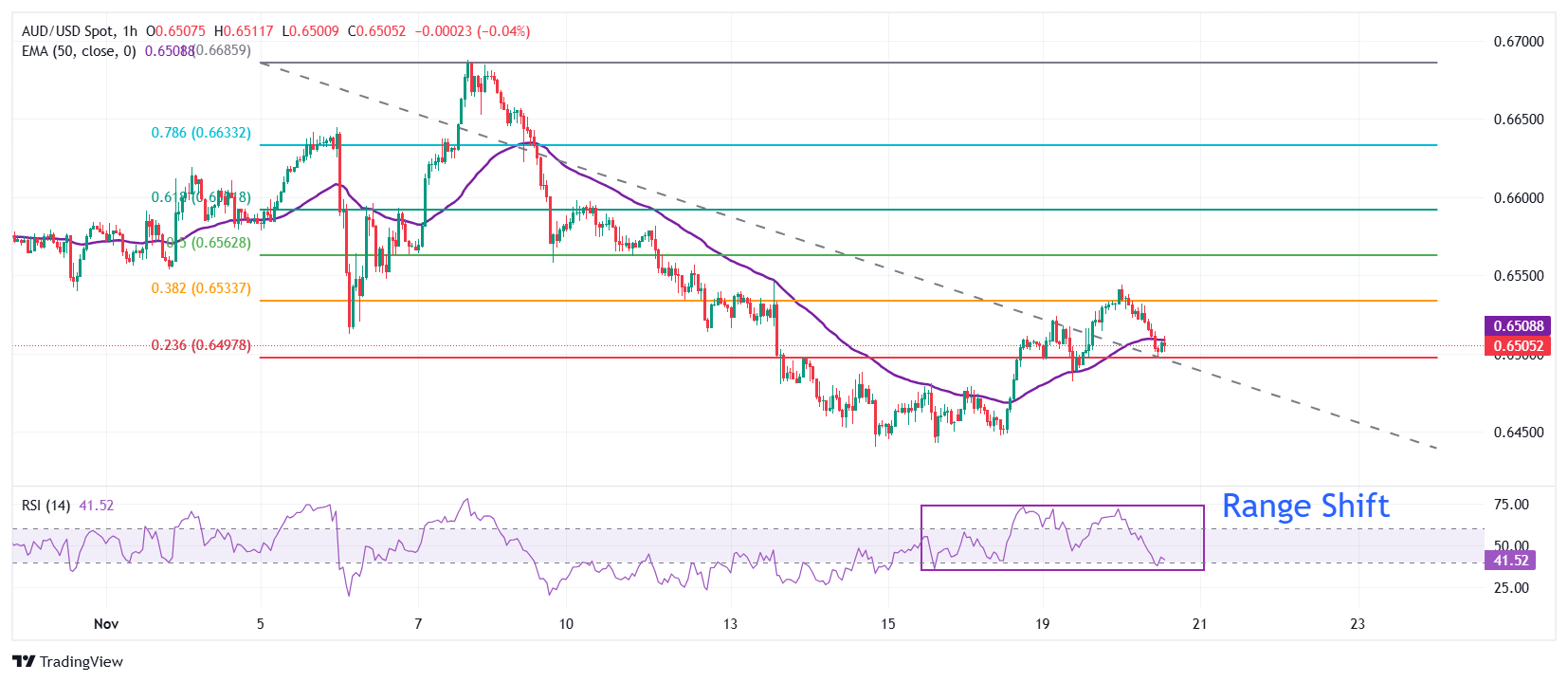AUD/USD Price Forecast: Slumps to near 0.6500 as Fed dovish bets ease
- AUD/USD falls sharply to near 0.6500 due to a strong recovery in the US Dollar.
- Market expectations for Fed rate cuts in December have slightly eased.
- AUD/USD falls back after failing to climb above 38.2% Fibo retracement at 0.6535.
The AUD/USD pair drops sharply to near the psychological support of 0.6500 in the North American trading session on Wednesday. The Aussie pair weakens as the US Dollar (USD) bounces back strongly as traders doubt whether the Federal Reserve (Fed) will cut interest rates again in the December meeting. The US Dollar Index (DXY), which tracks the Greenback’s value against six major currencies, rebounds to near 106.60.
The probability of the Fed cutting interest rates by 25 basis points (bps) to 4.25%-4.50% in December has diminished to 56% from 83% a week ago, according to the CME FedWatch tool.
Market speculation for Fed interest rate cuts in December has slightly diminished as investors expect President-elect Donald Trump’s economic agenda will boost United States (US) inflation and economic outlook.
The Australian Dollar (AUD) performs weakly even though the Reserve Bank of Australia (RBA) is expected to keep interest rates unchanged at 4.35% by the year-end. RBA Governor Michelle Bullock maintained hawkish guidance in her remarks in the press conference after the policy decision on November 5, remaining cautioned about upside risks to inflation.
AUD/USD retreats after failing to extend recovery above 38.2% Fibonacci retracement around 0.6535. The Fibo tool is plotted from the November 7 high of 0.6688 to the November 14 low of 0.6440 on an hourly timeframe. The asset wobbles around the 50-day Exponential Moving Average (EMA) near 0.6500.
The 14-day Relative Strength Index (RSI) oscillates in the 40.00-60.00 range suggesting a sideways trend.
A decisive recovery move above the intraday high of 0.6545 could push the asset towards the round-level resistance of 0.6600, followed by the November 5 high of 0.6645.
In an alternate scenario, the pair could witness a downside after sliding below the November 14 low of 0.6440, which would drag the asset toward the round-level support of 0.6400 and the August low of 0.6348
AUD/USD hourly chart

Australian Dollar FAQs
One of the most significant factors for the Australian Dollar (AUD) is the level of interest rates set by the Reserve Bank of Australia (RBA). Because Australia is a resource-rich country another key driver is the price of its biggest export, Iron Ore. The health of the Chinese economy, its largest trading partner, is a factor, as well as inflation in Australia, its growth rate and Trade Balance. Market sentiment – whether investors are taking on more risky assets (risk-on) or seeking safe-havens (risk-off) – is also a factor, with risk-on positive for AUD.
The Reserve Bank of Australia (RBA) influences the Australian Dollar (AUD) by setting the level of interest rates that Australian banks can lend to each other. This influences the level of interest rates in the economy as a whole. The main goal of the RBA is to maintain a stable inflation rate of 2-3% by adjusting interest rates up or down. Relatively high interest rates compared to other major central banks support the AUD, and the opposite for relatively low. The RBA can also use quantitative easing and tightening to influence credit conditions, with the former AUD-negative and the latter AUD-positive.
China is Australia’s largest trading partner so the health of the Chinese economy is a major influence on the value of the Australian Dollar (AUD). When the Chinese economy is doing well it purchases more raw materials, goods and services from Australia, lifting demand for the AUD, and pushing up its value. The opposite is the case when the Chinese economy is not growing as fast as expected. Positive or negative surprises in Chinese growth data, therefore, often have a direct impact on the Australian Dollar and its pairs.
Iron Ore is Australia’s largest export, accounting for $118 billion a year according to data from 2021, with China as its primary destination. The price of Iron Ore, therefore, can be a driver of the Australian Dollar. Generally, if the price of Iron Ore rises, AUD also goes up, as aggregate demand for the currency increases. The opposite is the case if the price of Iron Ore falls. Higher Iron Ore prices also tend to result in a greater likelihood of a positive Trade Balance for Australia, which is also positive of the AUD.
The Trade Balance, which is the difference between what a country earns from its exports versus what it pays for its imports, is another factor that can influence the value of the Australian Dollar. If Australia produces highly sought after exports, then its currency will gain in value purely from the surplus demand created from foreign buyers seeking to purchase its exports versus what it spends to purchase imports. Therefore, a positive net Trade Balance strengthens the AUD, with the opposite effect if the Trade Balance is negative.


